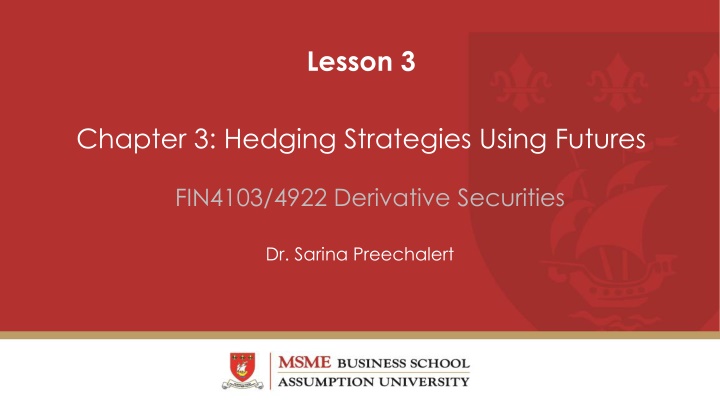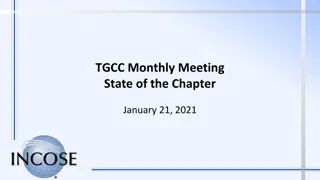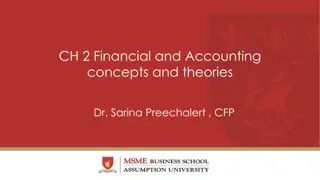
Hedging Strategies Using Futures in Derivative Securities
Explore the important concepts of hedging strategies using futures in derivative securities. Learn why firms hedge, factors involved in constructing a hedge, hedge ratios, examples of futures hedges, arguments for and against hedging, and the differences between long and short hedges. Understand when to use long or short futures hedges based on asset purchasing or selling plans. Consider the risks and appropriateness of various hedging situations for effective risk management.
Download Presentation

Please find below an Image/Link to download the presentation.
The content on the website is provided AS IS for your information and personal use only. It may not be sold, licensed, or shared on other websites without obtaining consent from the author. If you encounter any issues during the download, it is possible that the publisher has removed the file from their server.
You are allowed to download the files provided on this website for personal or commercial use, subject to the condition that they are used lawfully. All files are the property of their respective owners.
The content on the website is provided AS IS for your information and personal use only. It may not be sold, licensed, or shared on other websites without obtaining consent from the author.
E N D
Presentation Transcript
Lesson 3 Chapter 3: Hedging Strategies Using Futures FIN4103/4922 Derivative Securities Dr. Sarina Preechalert
Important Concepts in Chapter 3 Why firms hedge Hedging concepts Factors involved when constructing a hedge Hedge ratios Examples of futures hedges
Why Hedge? (1 of 2) The value of the firm may not be independent of financial decisions because Shareholders might be unaware of the firm s risks. Shareholders might not be able to identify the correct number of futures contracts necessary to hedge. Shareholders might have higher transaction costs of hedging than the firm. There may be tax advantages to a firm hedging. Hedging reduces bankruptcy costs. Managers may be reducing their own risk. Hedging may send a positive signal to creditors. Dealers hedge their market-making activities in derivatives.
Why Hedge? (2 of 2) Reasons not to hedge Hedging can give a misleading impression of the amount of risk reduced Hedging eliminates the opportunity to take advantage of favorable market conditions There is no such thing as a hedge. Any hedge is an act of taking a position that an adverse market movement will occur. This, itself, is a form of speculation.
Arguments in Favor of Hedging Companies should focus on the main business they are in and take steps to minimize risks arising from interest rates, exchange rates, and other market variables 5
Arguments against Hedging Shareholders are usually well diversified and can make their own hedging decisions It may increase risk to hedge when competitors do not Explaining a situation where there is a loss on the hedge and a gain on the underlying can be difficult 6
Long & Short Hedges A long futures hedge is appropriate when you know you will purchase an asset in the future and want to lock in the price A short futures hedge is appropriate when you know you will sell an asset in the future and want to lock in the price 7
SUMMARY OF HEDGING SITUATIONS CONDITION TODAY Hold asset Plan to buy asset Sold short asset RISK Asset price may fall Asset price may rise Asset price may rise APPROPRIATE HEDGE Short hedge Long hedge Long hedge Note: Short hedge means long spot, short futures; long hedge means short spot, long futures.
Basis Risk Basis is usually defined as the spot price minus the futures price Basis risk arises because of the uncertainty about the basis when the hedge is closed out 9
Basis risk The Basis (continued) This is the change in the basis and illustrates the principle of basis risk. Hedging attempts to lock in the future price of an asset today, which will be f0 + (St ft). A perfect hedge is practically non-existent. Short hedges benefit from a strengthening basis. All of this reverses for a long hedge.
TABLE : HEDGING PROFITABILITY AND THE BASIS TYPE OF HEDGE Short hedge BENEFITS FROM Strengthening basis WHICH OCCURS IF Spot price rises more than futures price rises or Spot price falls less than futures price falls or Spot price rises and futures price falls Long hedge Weakening basis Spot price rises less than futures price rises or Spot price falls more than futures price falls or Spot price falls and futures price rises Note: Short hedge means long spot, short futures; long hedge means short spot, long futures.
Basis Risk The Basis (continued) Example: March 30. Spot gold $1,387.15. June futures $1,388.60. Buy spot, sell futures. Note: b0= 1,387.15 1,388.60 = 1.45. If held to expiration, profit should be change in basis or 1.45. At expiration, let ST = $1,408.50. Sell gold in spot for $1,408.50, a profit of 21.35. Buy back futures at $1,408.50, a profit of 19.90. Net gain =1.45 or $145 on 100 oz. of gold.
Basis risk The Basis (continued) Example: (continued) Instead, close out prior to expiration when St = $1,377.52 and ft = $1,378.63. Profit on spot = 9.63. Profit on futures = 9.97. Net gain = 0.34 or $34 on 100 oz. Note that change in basis was bt b0or 1.11 ( 1.45) = 0.34. In forward markets, the hedge is customized so there is no basis risk.
Long Hedge for Purchase of an Asset Define F1: Futures price at time hedge is set up F2: Futures price at time asset is purchased S2: Asset price at time of purchase b2: Basis at time of purchase Cost of asset S2 F2 F1 S2 (F2 F1) =F1 + b2 Gain on Futures Net amount paid 14
Short Hedge for Sale of an Asset Define F1: Futures price at time hedge is set up F2: Futures price at time asset is sold S2: Asset price at time of sale b2: Basis at time of sale Price of asset S2 F1 F2 S2 +(F1 F2) =F1 + b2 Gain on Futures Net amount received 15
Hedging Concepts Contract Choice Which futures underlying asset? High correlation with spot Favorably priced Which expiration? The futures with maturity closest to but after the hedge termination date subject to the suggestion not to be in a contract in its expiration month Concept of rolling the hedge forward
TABLE :HOW TO DETERMINE WHETHER TO BUY OR SELL FORWARDS/FUTURES WHEN HEDGING Anticipated Future Spot Transaction Method 1. Determine what type of spot transaction you will be making when the hedge is terminated. a. Sell an asset. b. Buy an asset. 2. Given your answer in 1, you will need to terminate a forward/futures position at the horizon date by doing the opposite transaction to the one in 1 (e.g., if your answer in 1 is sell, your answer here is buy a forward/futures ). 3. Given your answer in 2, you will need to open a forward/futures contract today by doing the opposite (e.g., if your answer in 2 is buy a forward/futures, your answer here should be sell a forward/futures ).
Hedging Concepts Contract Choice (continued) Long or short? A critical decision! No room for mistakes.
Hedging Concepts Margin Requirements and Marking to Market low margin requirements on futures, but cash will be required for margin calls
Choice of Contract Choose a delivery month that is as close as possible to, but later than, the end of the life of the hedge When there is no futures contract on the asset being hedged, choose the contract whose futures price is most highly correlated with the asset price. This is known as cross hedging. 20
Optimal Hedge Ratio Proportion of the exposure that should optimally be hedged is where sS is the standard deviation of DS, the change in the spot price during the hedging period, sF is the standard deviation of DF, the change in the futures price during the hedging period r is the coefficient of correlation between DS and DF. * = S h F 21
Example Airline will purchase 2 million gallons of jet fuel in one month and hedges using heating oil futures From historical data sF =0.0313, sS =0.0263, and r= 0.928 0.0263 0.0313 h = = * 0.928 0.78 22
Example continued The size of one heating oil contract is 42,000 gallons The spot price is 1.94 and the futures price is 1.99 (both dollars per gallon) so that 000 2 94 1 . = F V = = 000 , = 3 880 , 000 , . , V A 1 99 42 000 , 83 580 , Optimal number of contracts is = 0.78 2,000,000 42,000 which rounds to 37 contracts 23
Alternative Definition of Optimal Hedge Ratio Optimal hedge ratio is = S h F where variables are defined as follows Correlation between percentage daily changes for spot and futures S F SD of percentage daily changes in spot SD of percentage daily changes in futures 24
Optimal Number of Contracts QA QF VA VF Size of position being hedged (units) Size of one futures contract (units) Value of position being hedged (=spot price time QA) Value of one futures contract (=futures price times QF) Optimal number of contracts after tailing adjustment to allow or daily settlement of futures hV V Optimal number of contracts if adjustment for daily settlement h* Q = A = A Q F F 25
Hedging Using Index Futures To hedge the risk in a portfolio the number of contracts that should be shorted is V A V F where VA is the value of the portfolio, b is its beta, and VF is the value of one futures contract 26
Example S&P 500 futures price is 1,000 Value of Portfolio is $5 million Beta of portfolio is 1.5 What position in futures contracts on the S&P 500 is necessary to hedge the portfolio? V = 1.5 ( 5,000,000/ 1,000) = 7,500 A V F 27
STOCK PORTFOLIO HEDGE (1 of 2) Scenario: On March 31, a portfolio manager is concerned about the market over the next four months. The portfolio has accumulated an impressive profit, which the manager wants to protect over the period ending July 27 using the standard S&P 500 futures contract. The prices, number of shares, and betas are as follows. STOCK PRICE (3/31) NUMBER OF SHARES MARKET VALUE ($) WEIGHT BETA Portfolio beta: 0.044(1.00) + 0.152(0.80) + 0.046(0.50) + 0.061(0.70) + 0.147(1.10) + 0.178(1.10) + 0.144(1.40) + 0.227(1.20) = 1.06. S&P 500 September futures contract (assumed to have a beta of 1.0): Price on March 31: 1,305 Multiplier: $250 Price of one contract: $250(1,305) = $326,250 Optimal number of futures contracts: Federal Mogul 18.875 18,000 339,750 0.044 1.00 Lockheed Martin 73.500 16,000 1,176,000 0.152 0.80 IBM 50.875 7,000 356,125 0.046 0.50 US West 43.625 10,800 471,150 0.061 0.70 Bausch & Lomb 54.250 21,000 1,139,250 0.148 1.10 First Union 47.750 28,800 1,375,200 0.178 1.10 Walt Disney 44.500 25,000 1,112,500 0.144 1.40 Tesoro 52.875 33,200 1,755,450 0.227 1.20 7,725,425 1.000
STOCK PORTFOLIO HEDGE (2 of 2) SELL 25 CONTRACTS STOCK Federal Mogul PRICE (7/27) MARKET VALUE ($) Results: The values of the stocks on July 27 are as follows: S&P 500 September futures contract: Price on July 27: 1,295.40 Multiplier: $250 Price of one contract: $250(1,295.40) = $323,850 Buy 25 contracts Analysis: The market value of the stocks declined by $7,725,425 $7,518,700 = $206,725, a loss of 2.68 percent. The futures profit was 21.625 389,250 Lockheed Martin 81.500 1,304,000 IBM 43.875 307,125 US West 47.125 508,950 Bausch & Lomb 45.875 963,375 First Union 48.125 1,386,000 Walt Disney 40.000 1,000,000 Tesoro 50.000 1,660,000 7,518,700 Thus, the overall loss on the stocks was effectively reduced to $206,725 $60,000 = $146,725, a loss of 1.90 percent.
Changing Beta What position is necessary to reduce the beta of the portfolio to 0.75? V A V F What position is necessary to increase the beta of the portfolio to 2.0? A V V F 30
TABLE : TARGET BETA STRATEGIES WITH STOCK INDEX FUTURES (1 of 2) Scenario: On August 29, a portfolio manager is holding a portfolio of stocks worth $3,783,210. The portfolio beta is 0.95. The manager expects the stock market as a whole to appreciate substantially over the next three months and wants to increase the portfolio beta to 1.25. The manager could buy and sell shares in the portfolio, but this would incur high transaction costs and later the portfolio beta would have to be adjusted back to 0.95. The manager decides to buy stock index futures to temporarily increase the portfolio s systematic risk. The prices, number of shares, and betas are the following. The target date for evaluating the portfolio is November 29. Portfolio beta: 0.122(0.95) + 0.187(1.10) + 0.203(0.85) + 0.048(1.15) + 0.059(1.15) + 0.076 1.00) + 0.263(0.85) + 0.042(0.75) = 0.95. December stock index futures contract: Price on August 29: 759.60 Multiplier: $250 Price of one contract: $250(759.60) = $189,900 Required number of futures contracts: STOCK PRICE (8/29) NUMBER OF SHARES MARKET VALUE ($) WEIGHT BETA Beneficial Corp. 40.50 11,350 459,675 0.122 0.95 Cummins Engine 64.50 10,950 706,275 0.187 1.10 Gillette 62.00 12,400 768,800 0.203 0.85 Kmart 33.00 5,500 181,500 0.048 1.15 Boeing 49.00 4,600 225,400 0.059 1.15 W. R. Grace 42.62 6,750 287,685 0.076 1.00 Eli Lilly 87.38 11,400 996,132 0.263 0.85 Parker Pen 20.62 7,650 157,743 0.042 0.75 3,783,210 1.000 Buy 6 contracts Results: The values of the stocks on November 29 are the following.
TABLE : TARGET BETA STRATEGIES WITH STOCK INDEX FUTURES (2 of 2) December stock index futures contract: Price on November 29: 809.60 Multiplier: $250 Price of one contract: $250(809.60) = $202,400 Sell 6 contracts Analysis: The market value of the stocks increased by $4,161,483 3,783,210 = $378,273, a gain of about 10 percent. The futures profit was SELL 25 CONTRACTS STOCK Beneficial Corp. PRICE (11/29) MARKET VALUE ($) 45.13 512,226 Cummins Engine Gillette 66.75 730,913 69.87 866,388 Kmart 35.12 193,160 Boeing 49.12 225,952 W. R. Grace 40.75 275,062 Eli Lilly 103.75 1,182,750 Parker Pen 22.88 175,032 4,161,483 Thus, the overall gain on the portfolio was effectively increased to $378,273 + $75,000 = $453,273, a return of about 12 percent.
Why Hedge Equity Returns May want to be out of the market for a while. Hedging avoids the costs of selling and repurchasing the portfolio Suppose stocks in your portfolio have an average beta of 1.0, but you feel they have been chosen well and will outperform the market in both good and bad times. Hedging ensures that the return you earn is the risk-free return plus the excess return of your portfolio over the market. 33
Stack and Roll We can roll futures contracts forward to hedge future exposures Initially we enter into futures contracts to hedge exposures up to a time horizon Just before maturity we close them out an replace them with new contract reflect the new exposure 34
Liquidity Issues In any hedging situation there is a danger that losses will be realized on the hedge while the gains on the underlying exposure are unrealized This can create liquidity problems One example is Metallgesellschaft which sold long term fixed- price contracts on heating oil and gasoline and hedged using stack and roll The price of oil fell..... 35


















